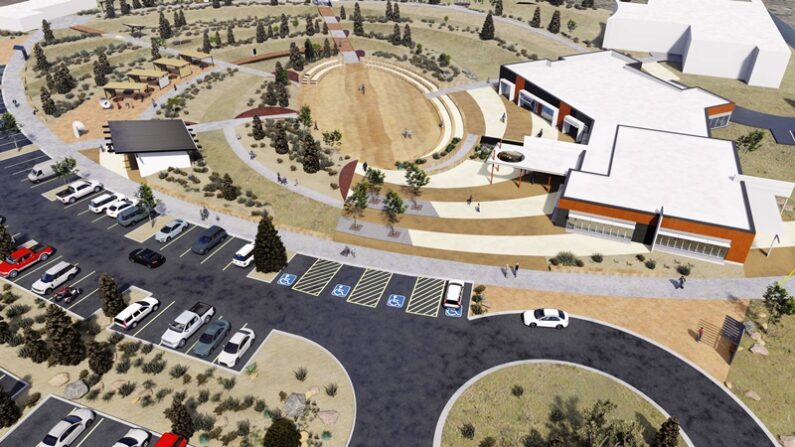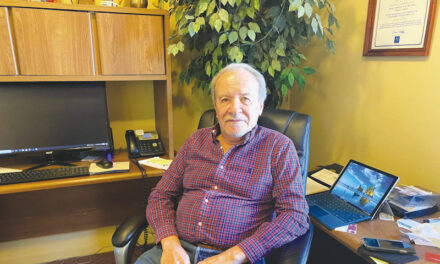
A pair of Interra employees take soil samples at the Eagle Picher Superfund site in February. The EPA announced $19 million for the clean-up in March.
Cathy Cook | El Defensor Chieftain
From new broadband coming to the area, to an expanding cannabis industry, 2022 has been a year full of economic changes and challenges. The year also brought new leadership locally and statewide, from a new Magdalena principal to a new District 2 Congressional representative. Here’s a look back at some of the biggest stories of the year.
TDS broadband
After months of research and discussion between the City of Socorro and TDS Telecom, the construction of a high-speed network was beginning to take shape in the latter part of 2022. Once completed, the network upgrade will provide 2,000 Mbps – 2 gig – symmetrical internet speeds matching download and upload speeds. Fast downloads are better for streaming videos and music, and shopping online, and the fast upload speeds mean users can video chat, game, livestream and upload to the cloud or social media without a hitch.
TDS adds that the network expansion will offer business customers internet access and transport connections up to 10 gigs via dedicated fiber and TDS-managed IP, a hosted VoIP communications solution.
TDS is working with CEC Facilities Group out of Irving, Texas to construct the network, which is planned in three-to-four phases encompassing four sections of town, involving both burial and aerial cables. CEC Facilities broke ground in October with one crew of workers around the central and western parts of Socorro. The first area includes installing about 18 miles of fiber and more than 1,400 service addresses.
Construction in the southern section, generally south of the Plaza serving 1,318 customers with 16.9 miles of fiber, should begin in January. Construction for the eastern section of Socorro, everything east of California Street to serve 1,308 customers with 18.8 miles of fiber, is targeted to begin in May.
More crews will be brought in to construct the network through the winter months. This project is solely a private-sector investment from TDS. No government support funds will be used.
Magdalena broadband
Word came in November that Socorro Electric Cooperative was to receive close to $10 million for a high-speed internet project in Magdalena. SEC was named one of four recipients splitting up a $38.6 million grant through the Connect New Mexico Pilot Program to bring Red Bolt Broadband access across New Mexico.
Magdalena is a pilot project for SEC, and it is expected to cost between $7-10 million. In addition to providing the infrastructure and labor, SEC is kicking in $1.3 million as part of matching funds for the project, which is expected to cost $29,000 each for an estimated 300 structures, homes, or businesses in the village.
The Magdalena project is still in the design phase, but SEC General Manager Joseph Herrera hopes it can be completed by the end of next year as each installation will help their crews gain experience and move faster.
Nothing has been contracted, but SEC may partner with another entity to bring high-speed internet to the Alamo Navajo community.
No cost to customers for monthly service has been released, but the average price of the 1-gigabyte service is an estimated $90 per month.

Elijah Rosas catches voters’ attention on Election Day. Photo by Russell Huffman.
Election
Both the state Senate and House redistricting maps for New Mexico were made a reality with the 2022 election cycle. Socorro County voters in three separate house districts chose
Democrat Tara Jaramillo over Republican Sandy Hammack in District 38. Gail Armstrong was unopposed in District 49, and Harry Garcia was unopposed in District 69.
Gabe Vasquez narrowly defeated Yvette Herrell in the Second District congressional race.
Incumbent Governor Michelle Lujan Grisham was re-elected for a second term, and Maggie Toulouse Oliver remains Secretary of State.
On the county level, Republican Lee Armijo defeated Democrat Demecio Silva for Socorro County Sheriff. Incumbent Julie Griego was unopposed for her County Assessor position. In the county commission, Democrats Joe Gonzales in District 1 and John Aguilar in District 3 were both unopposed. Gilbert Peralta was unopposed for Probate Judge. Sitting Magistrate Judge Felix Saavedra was also unopposed. Roscoe Woods was retained as Seventh Judicial District Judge.
In Magdalena, voters approved an ordinance allowing restaurants to serve beer and wine.
New middle school planned

An early concept of how the new middle school building would be configured.
Courtesy SCSD
Construction of a brand-new school building in Socorro is slow going, but Consolidated School District Superintendent Ron Hendrix announced that everything’s right on track for a new middle school building on the same property as Socorro High School. He said the Educational Specifics portion has been wrapped up by the state.
“They’ve got some preliminary designs,” Hendrix said in July. “They gave us a one-story version and a two-story version.”
The new building will feature a couple of features missing from Sarracino Middle School including a culinary arts lab and a separate room for robotics. The new building will be between the baseball field and the old softball field. Hendrix said although the proximity to the high school is close, the design and location of the school emphasize student separation. “We don’t want middle schoolers mixing with high school kids,” he said.
The Sarracino building was designed for 700 students, and the current student body is down to 330. Hendrix said the heating and cooling expenses for a half-empty building were a financial drain on the district. Besides that, there are other issues with the Sarracino building.
“The issues took in the floors, ceiling and wall finishes, all the HVAC and lighting,” Hendrix said. “Just about everything you can think of needs to be redone. The fire suppression system needed to be redone. All the intercom and communication systems in it.”
He said the design stage will take anywhere from nine to 12 months. When all is said and done, Hendrix anticipates the new middle school should be ready for students not before “well into the 2023-24 school year.”
Eagle Picher cleanup funding
The Environmental Protection Agency announced in March, the Eagle Picher Battery Superfund site is set to receive $19 million in federal funds to clean it up, with the money split into $3 million for soil excavation and building demolition, and $16 million for a pump-and-treat remedy for the contaminated groundwater. The New Mexico Environment Department will be contracting the cleanup work and using some local labor.
The Eagle Picher factory on the north end of the city limits manufactured printed circuit boards from 1964 to 1976, dumping industrial waste in unlined lagoons at the site. From 1980 to 1989, the company made lead-acid batteries and dumped more industrial waste into the lagoons. In 2007, it became a Superfund site and was listed on the National Priorities List.
In a bankruptcy settlement, the Eagle Picher company paid $4 million to the EPA, which the agency and NMED used for feasibility studies and to design a remediation plan, but not enough to clean up the pollutants, which include TRC (trichloroethylene), lead and asbestos.
According to Supervisory Environmental Engineer Blake Atkins, the soil evacuation can begin quickly and may be complete within two to three years. Spots in the soil with elevated levels of lead and other metals will be excavated and backfilled with other soil. Remediation for asbestos and lead paint will also be done on existing structures.
Treating the groundwater contamination will take much longer. The EPA already has a design to pump, treat and reinject water, which it may pursue. However, that approach requires a lot of expense and maintenance, so they are examining other options to make sure they choose the best treatment for the water.
NMED Secretary James Kenney said that holding polluters accountable is crucial because there is already too much legacy pollution in the state.
New Magdalena principal
In the wake of the unexpected departure of longtime Principal Leslie Clark, Magdalena School’s superintendent Glenn Haven took over the principalship temporarily until a replacement could be found. In July, that position was filled by Chris Backstrom. Backstrom has been an educator for 15 years, including two years as an administrator. In the 2014 to 2015 school year and the 15 to 16 school year, he worked as assistant principal and athletic director at Socorro High School. He also taught at Sarracino Middle School for six years.
As Magdalena High School principal Backstrom told the Chieftain in August that some of the biggest challenges this school year will be getting the school fully staffed with certified qualified staff members amid a national teacher shortage. Improving student attendance will also be a challenge.
One of his goals is to create an AVID culture on campus. AVID is a program that promotes college and career readiness. The school has an AVID elective class already, which focuses on teaching students organizational skills, college preparedness and critical thinking.
Backstrom’s other goals include keeping a strong interaction with kids and teachers, maintaining the school’s focus on short-cycle assessment data, and keeping a positive school climate. The school already has a data-driven approach, where regular language arts and math testing is used to make sure students are on track and provide interventions when needed.

Police Captain Angel Garcia named Chief of Police
Chief of Police Angel Garcia
In September, Mayor Ravi Bhasker made official the appointment of Assistant Police Chief Angel Garcia to the position of Chief of Police. Garcia succeeds Mike Winders, who has been Socorro’s Police Chief since 2014 and retired in October after just shy of 25 years with the department.
Bhasker named Kenneth Greenwood as Assistant Chief. He said Greenwood is an asset to the force and has shown to be on top of the department’s paperwork.
Garcia, who entered the force as a patrolman in 1998, said he was ready to get started as Chief of Police.
“You know, I’ve been with the Socorro Police Department going on almost 24 years,” he said. “I think we have a great group of guys and am looking forward to adding a few more people. We are hiring.”
Garcia entered the force as a patrolman in 1998. After that, he spent several years as a detective working in narcotics investigations, and eventually moved up to captain and then to assistant chief under Winders.
Garcia said he is committed to working hand-in-hand with officers and being proactive in the community. “I want everyone to know they can speak to me on any concerns they have in their neighborhood or just want to give us some information. I’m always available,” he said.
Drought and irrigation

Farmer Glen Duggins shows one of his private wells.
Juan Baeza | El Defensor Chieftain Intern
The 2022 irrigation season was cut short due to drought once again. With an irrigation season that usually runs till October, the Middle Rio Grande Conservancy District told farmers early on that the season could be over before June ends. That could be devastating for Socorro’s local farmers as many of them do not have private wells on their land to maintain throughout the season.
In a June interview, Mario Rosales said dealing with drought is all part of the game, and valley farmers were planning to get by the 2022 season just like they have done in the past.
He said there’s no point in getting mad or trying to find someone to blame. As a former ditch rider, Rosales understands both sides—the farmers and the ditch riders. Ditch riders are MRGCD employees who manage the irrigation ditches. Rosales understands that people can get anxious, but he says that there’s nothing the MRGCD or ditch riders can do.
“If there’s no water, then there’s no water. We got to leave the rest to the man upstairs and rock with what we have.”
Despite the drought, Rosales was confident they will get through because this was something they have faced before.
“Somehow, someway, we have always made it through. The water always ends up coming from somewhere. We just keep our faith and continue with the job.”
It was reported in the ensuing weeks that the monsoon rains had been beneficial for crops and rangeland across New Mexico as many farmers and ranchers entered harvest season.
Co-op restructures rates
After three years of refusing to do so, in May the Socorro Electric Coop agreed to restructure its rates as directed in 2019 by the New Mexico Public Regulation Commission. This comes as a compromise between SEC and the NMPRC Utility Division Staff after several years of back and forth. SEC said the new rates would be in place by the June billing cycle but is still appealing the rate redesign to the state Supreme Court.
The rate redesign does not increase revenue for the Coop, but it does make quite a few changes to the rate structure. These changes include raising residential rates and lowering rates for large commercial customers.
If it is unsuccessful in its rate case appeal to the state’s Supreme Court, SEC will adjust the accounts of customers affected by the changes over a time period that was yet to be determined.
SEC is withdrawing all of its appeals except for its initial appeal of the order that it restructure rates. SEC has also not waived any rights to appeal the fines imposed by the Commission.
Fentanyl
Within the first two weeks in October, two Socorro High School students were found with fentanyl on the campus. While this was the first time fentanyl has ever been found in a student’s possession while on campus at one of the Socorro schools, no one has been caught selling drugs at the middle or high school, according to Superintendent Ron Hendrix.
The incidents have the school board and the district administration worried. One of the students seemed high when fentanyl was found in their possession, Hendrix told the Chieftain, although they could not test the student to verify that assumption.
Hendrix’s biggest concern is that a student could die from fentanyl use.
The school board and Hendrix want parents to pay close attention to their high school and middle school students.
One of the ideas for addressing drugs being brought into school is to implement a “dads on duty” program, like the kind created in a Louisiana school district, Hicks said.
Another idea is to bring the Coordinated Community Response (CCR) person working for Positive Outcomes, into the high school.
JC Trujillo of Casa de Luz – a branch of Positive Outcomes – said that one issue he’s seen is fentanyl liquified into vapes. Some of the youth he’s spoken with have no difficulty acquiring fentanyl.
The school district already has cameras directed at the high school and middle school bathrooms and has recently installed vape detectors in the bathrooms at the high school and middle school. The vape detectors were installed to detect marijuana use on the school campuses but are also capable of detecting other substances, said Hendrix.
The district has also ordered drug testing kits, so the principals can quickly test suspected fentanyl if they find any more in their schools.

Artist’s concept of the proposed VLA STEM Learning Center.
Courtesy image
VLA
Since going operational in 1980, the Very Large Array in Socorro County has seen continual upgrades and additions, and in April 2022, the National Radio Astronomy Observatory facility announced a planned project that would expand and enhance learning opportunities for STEM students.
The idea is simple; to create a facility adjacent to the array operations building that would serve in-person and virtual STEM education to K-12 students, and enlarge and enhance the visitor center, said Dave Finley, press officer for NRAO in Socorro. The proposed Next Generation Learning Center will be located adjacent to the array’s operation building at the Very Large Array and would incorporate and expand what the VLA has provided over the years.
The facility will be known as a visitor center/museum, making it more enhanced than the existing visitor center, and Dave Finley says the proposed Learning Center would be a state-of-the-art facility serving both STEM education and conceivably give Socorro County an economic boost from increased tourist dollars
He said NRAO has been working on this upgrade for some time.
“Our funding agency is the National Science Foundation,” he said. “They are very supportive of STEM education, both formal and informal, and so it will be part of our normal running of the VLA and then the next generation VLA.”
In addition, the admission fees and gift shop sales will contribute significantly in helping to support the operations and maintenance, Finley said.
The planned Next Generation Learning Center at the Very Large Array needs almost $21 million in state funding after the project was unable to secure federal funding. The Socorro County Commissioners have agreed to act as a fiscal agent for the NRAO’s proposed Next Generation Learning Center, which will focus on science, technology, engineering and math education.
County senior centers
Maintaining operational funding for the three Socorro County senior centers has been a balancing act for the county in recent years, and the county commission once more asked the state government for relief to no avail. Although the financial burden of maintaining services for the seniors of Socorro County hasn’t gone away, the county commission in December took steps to keep the three centers open and operating through June 2023. This necessitated the transference of $450,000 from the county’s general fund to keep the state-mandated senior program functioning as normal for the next six months.
County Manager Michael Hawkes asserted the move will continue to cause financial problems for other county departments, such as the road department. Other county-mandated services could conceivably come up with shortfalls and be a drain on other departments, county-wide.
Hawkes said the senior program’s shortfall had nothing to do with how the county’s money is allocated.
“It’s a state-mandated program that the state doesn’t adequately provide money for. That means funding,” the county manager said.
Hawkes and the commissioners are hoping the governor and state lawmakers will help the county find a solution in the coming legislative session.
Recreational cannabis leads to economic growth

The former alfalfa farm is a research project run by “Weeds. Cannabis Consulting,”
Cathy Cook | El Defensor Chieftain
The first week after recreational sales of cannabis became legal in April, business doubled at one dispensary – Natural RX – in Socorro. The increase in sales portended new jobs in the fledging weed market.
Statewide, almost $10 million in cannabis sales was reported by the middle of April, with $3.9 million in medical sales and $6.1 million in recreational cannabis sales. In Socorro, there were a total of $69,520 in cannabis sales. That breaks down to $31,103 in medical cannabis sales and $38,417 in recreational cannabis sales.
Sales at Natural RX were slightly lower than anticipated. In the ensuing months, they were running short of products, and the retailer worked to expand their garden, requiring more trimmers and more delivery drivers.
Manager Anthony Torres said one complication was that previous to legalization the company was only allowed to grow so many plants.
After plants are harvested, they still have to be cured for 10 days and sent to labs for testing. The cannabis is tested for microbials, bacteria, mold, THC potency, and sometimes even for terpenes, which affect the smell and taste. The store sells a wide range of cannabis products, including concentrates, edibles and topicals.
Elsewhere in Socorro, on a former alfalfa farm, 400 cannabis plants were growing in rows of large pots this July. The goal of the farm is not retail success but data.
The farm is a research project run by “Weeds. Cannabis Consulting,” a business that helps growers and retailers navigate the complexities of the newly expanded cannabis industry. The goal of the farm is to find new strains that will grow well in the New Mexico heat and test a few already popular strains to find the most economical way to grow them.

Workers pile debris from the ruins of the vacant Sands Motel.
Cathy Cook | El Defensor Chieftain
Sands Motel demolished
Demolition of the dilapidated Sands Motel was accomplished in July. Socorro’s City Council had condemned the vacant motel the previous June. Located on California Street, the derelict buildings have not only been an eyesore, but also a spot where people sometimes seek shelter. Some of the rooms still had beds and mattresses. Dating back as far as 2018, law enforcement officers have discovered used drug paraphernalia inside rooms and had to respond to trespasses, burglaries and at least one structure fire on the property.
Efforts to clean up the property were slowed down when asbestos was found and demolishing the building had to wait until the asbestos was remediated. Remediation cost the city $134,000. A certified hazardous waste contractor began that work in May.
The city administration plans to place a lien against the property in an estimated $180,000 to $200,000 range to recoup expenses after the site is cleaned up, according to previous coverage.
The razing took about a week.
Compiled by John Larson



















